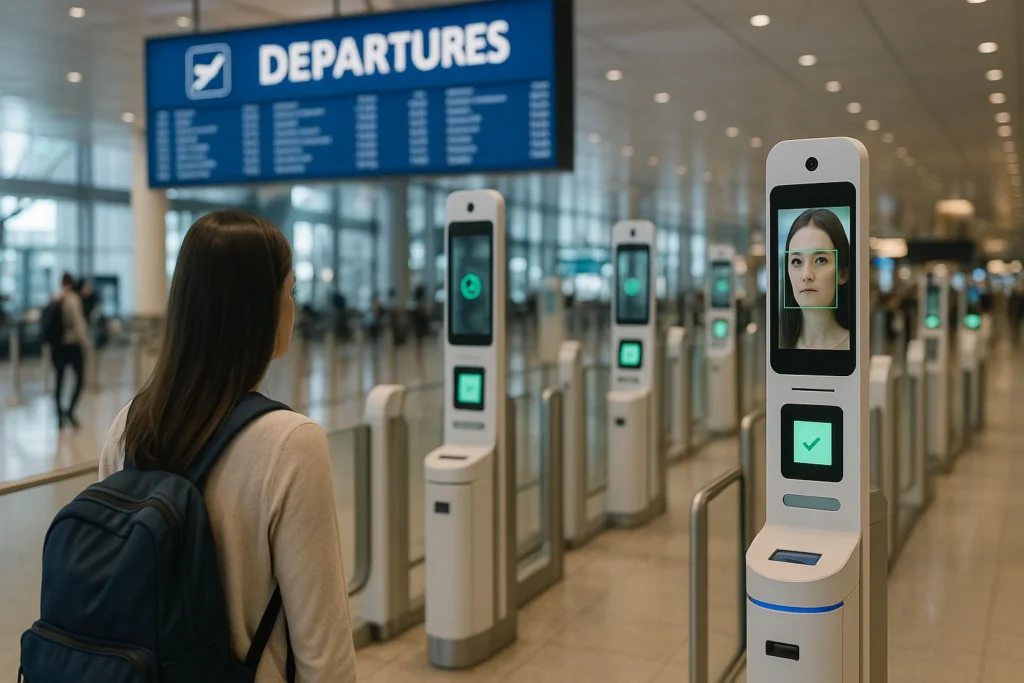Introduction: Flying into Tomorrow’s Terminal
Imagine walking into an airport, not needing to pull out your passport or boarding pass, simply gliding through check-in and security with a glance, and finding your gate guided by real-time smart displays that adapt to your pace. This isn’t a scene from a science fiction movie anymore. Across the globe, major aviation hubs are rapidly transforming, integrating Artificial Intelligence (AI) into nearly every facet of their operations. From facial recognition check-ins to predictive systems that anticipate your needs, airports in global cities like Dubai, Singapore, and Tokyo are leading this charge, fundamentally changing how we experience air travel.
This isn’t just about making things faster; it’s about making them smarter, safer, and remarkably more seamless. AI is becoming the silent co-pilot of airport operations, optimizing everything from baggage handling to security protocols, ultimately striving for a future where flying is less about stress and more about a smooth, intuitive journey. Let’s explore how these “AI-powered airports” are literally flying us into the future.
Beyond the Boarding Pass: The Biometric Revolution
One of the most immediate and noticeable changes brought by AI in airports is the shift towards biometric authentication, primarily facial recognition. The days of fumbling for your passport and boarding pass at multiple checkpoints are quickly becoming a relic of the past.
In leading airports, the journey often begins with a single facial scan at a self-service kiosk or dedicated lane. This initial scan links your face to your flight details and passport information. From there, your face becomes your “boarding pass.” You simply look into a camera at bag drop, security checkpoints, and even at the boarding gate. AI algorithms quickly and accurately verify your identity against the stored data, allowing you to pass through with remarkable speed.
This biometric revolution is driven by sophisticated AI that can process images in milliseconds, identify individuals even in crowded environments, and integrate seamlessly with airline and immigration databases. It significantly reduces queues, enhances security by ensuring the person traveling is indeed who they claim to be, and offers a truly touchless experience, which has become even more appealing in recent times.
Singapore’s Changi Airport, for instance, has been a pioneer in deploying extensive facial recognition systems to expedite passenger verification, making check-ins and security checks much smoother. Dubai International Airport (DXB) has also rolled out “Smart Gates” that utilize facial and iris recognition to speed up immigration processes for arrivals and departures, transforming what was once a time-consuming bottleneck into a quick, intuitive passage.
The Brain Behind the Baggage: Predictive Systems & Logistics
Beneath the polished floors and soaring ceilings of modern terminals, AI is hard at work optimizing the complex dance of airport logistics. It’s not just passengers who benefit from AI; the entire operational backbone of an airport is becoming more intelligent.
- Predictive Passenger Flow: AI analyzes real-time data from flight schedules, weather forecasts, security wait times, and even social media sentiment to predict passenger surges and bottlenecks. This allows airport management to proactively adjust staffing at check-in counters, security lanes, and immigration, preventing long queues before they even form.
- Optimized Gate Allocation: Assigning gates to hundreds of incoming and outgoing flights is a colossal puzzle. AI algorithms consider factors like aircraft size, arrival/departure times, connecting flights, ground service requirements, and even airline preferences to optimize gate usage, minimizing delays and reducing taxi times on the tarmac.
- Intelligent Baggage Handling: Lost luggage is every traveler’s nightmare. AI-powered systems are revolutionizing baggage handling by tracking bags in real-time, predicting potential misroutes, and optimizing conveyor belt systems for efficiency. Autonomous machines and robotics are increasingly being integrated into baggage sorting and transport, reducing errors and speeding up delivery. Dubai’s upcoming Al Maktoum International Airport expansion, for example, is planning for extensive use of autonomous machines in baggage handling.
- Predictive Maintenance: AI monitors the health of critical airport infrastructure – from baggage conveyor belts and escalators to air conditioning systems and runway lights. By analyzing sensor data, AI can predict when a component is likely to fail, allowing maintenance teams to schedule repairs before a breakdown causes costly disruptions. This proactive approach ensures smoother operations and fewer unexpected delays.
These predictive capabilities turn raw data into actionable insights, enabling airport operations teams to shift from reacting to problems to proactively optimizing the entire airport environment.
Guardians of the Skies: AI in Security & Safety
Airport security has always been a tightrope walk between ensuring safety and maintaining efficiency. AI is tilting this balance in favor of both, making security more robust and less intrusive for legitimate travelers.
- Advanced Threat Detection: AI algorithms can analyze vast amounts of data from surveillance cameras, X-ray scanners, and biometric systems in real time. They are trained to identify suspicious behaviors, unattended bags, or unusual patterns that might indicate a threat, flagging them for human review faster and more accurately than traditional methods. This intelligent video analytics can spot anomalies in crowd movement or individual actions that might otherwise go unnoticed.
- Enhanced Screening: AI is integrated into baggage and passenger screening systems to improve the detection of prohibited items. For instance, advanced computer tomography (CT) scanners coupled with AI can create 3D images of bags, allowing the AI to identify dangerous objects more effectively and reduce the need for manual bag checks.
- Cybersecurity Defense: Modern airports are digital ecosystems, making them potential targets for cyberattacks. AI-powered cybersecurity systems continuously monitor network traffic, detect unusual activity, and respond to threats in real-time, safeguarding sensitive passenger data and critical operational systems.
- Emergency Response Optimization: In the event of an emergency, AI can assist by analyzing real-time data from sensors and cameras to identify the fastest evacuation routes, deploy emergency services efficiently, and provide crucial information to first responders, significantly improving response times and coordination.
By augmenting human capabilities with intelligent automation, AI transforms airport security into a dynamic, adaptive system, ensuring a safer environment for everyone without necessarily slowing down the travel experience.
The Human Touch (Enhanced): AI-Powered Customer Service
While AI automates many processes, it also plays a crucial role in enhancing the passenger experience by providing smarter, more personalized customer service. The goal isn’t to replace human interaction entirely, but to empower it and make it more efficient.
- AI Chatbots and Virtual Assistants: Many airports now employ AI-powered chatbots on their websites, mobile apps, and even physical kiosks. These chatbots can answer common questions about flight status, gate changes, baggage claim, airport facilities, and transportation options in multiple languages, providing instant support and freeing up human staff for more complex inquiries.
- Personalized Information: Leveraging AI and data analytics, airports can provide highly personalized updates. Imagine receiving a notification on your phone with the fastest route to your specific gate, real-time updates on your baggage status, or even tailored offers for shops and restaurants based on your preferences and time until boarding.
- Robotic Assistance: Robotic concierges are becoming a more common sight. Singapore Changi Airport, for example, is testing robots that can clean terminals, assist with trolley returns, and even deliver food and beverages directly to passengers. These robots, often equipped with AI for navigation and interaction, can provide directions, answer basic questions, and enhance the overall “futuristic” feel of the airport.
- Real-time Language Translation: For international travelers, AI-powered translation tools can break down language barriers, making interactions with airport staff and navigating information much easier.
These AI tools create a more intuitive and responsive environment, making passengers feel more informed, supported, and less stressed throughout their journey.
Dubai’s Grand Vision: The AI Ecosystem Unleashed
Dubai is not just integrating AI into its airports; it’s building an entire AI-powered ecosystem around its urban and travel infrastructure. The ambition is to make AI a foundational element of daily life and public services, with its airports at the forefront.
While the aspiration is to be “fully powered by AI,” Dubai’s approach is a strategic, comprehensive blueprint. The massive expansion of Al Maktoum International Airport (DWC) is designed with AI optimization at its core, aiming to be the world’s largest airport with a capacity of 260 million passengers annually. This involves:
- Autonomous Machines: Extensive use of AI-powered autonomous machines for efficient baggage handling and cargo operations.
- Predictive Analytics: AI for optimizing construction timelines, resource allocation, and forecasting trade trends.
- Smart Traffic Management: AI-driven adaptive signals and monitoring systems extend beyond the airport to reduce congestion on roads leading to and from the terminals, improving overall urban mobility.
- Biometric Smart Gates: As mentioned, these are already active at Dubai International Airport (DXB), streamlining immigration for millions of travelers.
- AI-powered Chatbots: Even Dubai Police use an “AI officer” chatbot at kiosks to assist residents and tourists, showcasing the broad integration of AI into public services.
Dubai’s vision is about more than just airport efficiency; it’s about leveraging AI to create a seamless “city experience” that extends from arrival at the airport to urban exploration and departure, positioning itself as a global leader in AI adoption.
Singapore Changi: The Smart Airport Blueprint
Singapore Changi Airport consistently ranks among the world’s best, and its “SMART Airport Vision” is a key reason why. Changi is not merely adopting AI; it’s using it to redefine the entire travel experience, from pre-arrival to post-journey.
Changi Airport Group (CAG) is renowned for its strategic use of data and AI to gain deep insights into passenger behavior and preferences. This allows them to personalize experiences and unlock operational efficiencies. Key initiatives include:
- Agentic AI Exploration: CAG is exploring “agentic AI,” an advanced form of AI that can predict and recommend next steps in various scenarios. For instance, if a flight is delayed or a passenger needs assistance, agentic AI could automatically trigger necessary actions – such as re-booking connections, notifying ground staff, activating cleaning crews, or making timely announcements – all while optimizing resources.
- Extensive Robotics: Changi is a leader in deploying robots for practical tasks. Beyond cleaning, robots are being tested for returning trolleys to designated bays and even delivering food and beverages directly to passengers within the terminal.
- Facial Recognition: As highlighted earlier, Changi was an early adopter of AI-driven facial recognition systems for expedited check-ins, security, and boarding, significantly reducing wait times and improving passenger flow.
- Data-Driven Personalization: By harnessing vast amounts of behavioral and transactional data, Changi can tailor experiences, offers, and information to individual passengers, making their journey more intuitive and enjoyable.
Changi’s approach emphasizes starting small, testing, and scaling successful technologies, creating a seamless, personalized, and highly efficient travel environment that extends beyond the terminal walls.
Tokyo’s Precision: Efficiency and Cleanliness Through AI
Tokyo’s airports, particularly Haneda (HND) and Narita (NRT), are globally renowned for their efficiency, punctuality, and cleanliness. While their AI integration might be less about grand, sweeping declarations than some, it’s deeply embedded in critical operational aspects, leveraging AI for precision and reliability.
- Haneda Airport: The World’s Cleanest: Tokyo Haneda Airport has repeatedly been crowned the world’s cleanest major airport. This isn’t just due to human effort; it leverages AI and automation. Haneda utilizes UV sanitizing robots for nighttime disinfection and features superior, touchless bathrooms, some even with unique “bowing” seats for a distinctly Japanese touch on hygiene. While not solely AI, AI-powered cleaning systems and robotic assistants contribute to maintaining its impeccable standards.
- Narita Airport: AI-Powered Waste Sorting: Narita Airport has implemented AI-powered waste sorting systems, which automatically categorize and separate different types of waste. This not only enhances efficiency in waste management but also supports the airport’s sustainability goals by improving recycling efforts.
- Operational Optimization: Like other major hubs, Tokyo’s airports use predictive analytics to manage passenger flow and gate assignments, ensuring their legendary punctuality. While specific large-scale biometric rollouts might be more gradual compared to Dubai or Singapore, the focus is on robust, reliable systems that contribute to a consistently high-quality passenger experience. The recent shift of Air India flights to Haneda from Narita, driven by Haneda’s closer proximity to downtown Tokyo, further highlights the emphasis on operational efficiency and passenger convenience.
Tokyo’s airports exemplify how AI can be subtly yet powerfully integrated to enhance core strengths like cleanliness, precision, and efficiency, contributing to an overall seamless and pleasant travel experience.
The Unseen Hurdles: Navigating Privacy and Complexity
While the benefits of AI-powered airports are compelling, the journey to a fully intelligent travel ecosystem is not without its challenges and concerns.
- Data Privacy: The extensive use of biometric data (facial scans, iris patterns) and the collection of vast amounts of passenger information raise significant privacy concerns. Airports and airlines must ensure robust data protection frameworks, transparent policies on data usage, and compliance with stringent global privacy regulations like GDPR. Building public trust that personal data is secure and used responsibly is paramount.
- Cybersecurity Risks: As airports become more interconnected and reliant on AI systems, they also become more vulnerable to sophisticated cyberattacks. A breach could compromise sensitive data or disrupt critical airport operations, leading to chaos. Robust cybersecurity measures, constant monitoring, and resilient backup systems are essential.
- Integration Complexity: Integrating diverse AI systems into existing, often legacy, airport infrastructure is a monumental task. Ensuring seamless interoperability between different technologies (baggage handling, security, air traffic control, customer service) from various vendors requires meticulous planning and significant investment.
- User Acceptance and Bias: While many travelers welcome faster processes, some may be uncomfortable with the widespread use of biometrics. Furthermore, AI algorithms, if not carefully designed and trained on diverse datasets, can exhibit biases, potentially leading to discriminatory outcomes. Regular audits and ethical guidelines are crucial to ensure fairness and inclusivity.
- Job Displacement: The automation brought by AI and robotics inevitably raises concerns about job displacement for certain roles within airports. While new jobs may be created in AI management and maintenance, a proactive approach to reskilling and upskilling the existing workforce is necessary to manage this transition.
- Cost of Implementation: Implementing advanced AI solutions across an entire airport is a massive financial undertaking, requiring substantial investment in hardware, software, and skilled personnel.
Addressing these challenges requires a collaborative effort from airport authorities, airlines, technology providers, governments, and passengers themselves, ensuring that the benefits of AI are realized responsibly and equitably.
The Future Takes Flight: What’s Next for AI in Travel
The AI transformation in airports is still in its early stages, with exciting advancements on the horizon that promise to make air travel even more seamless, personalized, and efficient.
- Hyper-Personalization: Expect AI to offer even more tailored experiences. From personalized digital assistants that guide you through every step of your journey, anticipating your needs before you express them, to dynamic pricing models that offer customized deals on food and retail based on your profile and real-time airport conditions.
- Predictive Operations for Entire Networks: AI will move beyond individual airport optimization to predict and manage disruptions across entire airline networks. This means real-time re-routing of flights, dynamic crew scheduling, and proactive communication to minimize passenger inconvenience even before a problem fully materializes.
- Advanced Robotics and Autonomous Vehicles: We’ll see more sophisticated robots assisting with everything from cleaning and security patrols to baggage delivery straight to your hotel. Autonomous vehicles might transport passengers across vast airport complexes or even facilitate urban air mobility, seamlessly connecting downtown areas to airport terminals.
- Digital Twins: Airports are creating “digital twins” – virtual replicas of their physical infrastructure. AI can use these digital twins to simulate various scenarios, test new operational strategies, and predict the impact of changes (like a new terminal layout or a surge in passenger numbers) before they are implemented in the real world.
- Voice and Gesture Control: Beyond facial recognition, airports might incorporate more voice and gesture-controlled interfaces, allowing for completely hands-free interaction with kiosks, information displays, and even security checkpoints.
The ultimate vision is a fully integrated, self-optimizing airport environment that not only moves passengers and luggage efficiently but also anticipates and responds to the dynamic needs of a global travel system.
Conclusion: A Seamless Journey, A Smarter World
The rise of AI-powered airports is a powerful testament to how technology is continuously reshaping our lives, particularly the way we experience travel. The transition from manual processes to intelligent, automated systems is not just an upgrade; it’s a fundamental reimagining of the airport as a highly efficient, secure, and increasingly intuitive hub.
Leading the charge are airports in Dubai, Singapore, and Tokyo, which are setting new benchmarks for efficiency and passenger experience through comprehensive AI integration. From the swift passage offered by facial recognition to the unseen intelligence optimizing baggage flows and security, AI is becoming the essential, invisible infrastructure of modern air travel.
While challenges related to data privacy and integration remain, the trajectory is clear: airports will continue to leverage AI to become smarter, more resilient, and more responsive. The future of flying promises a journey that is not just about reaching a destination, but about experiencing a seamless, connected, and intelligent passage through the very gateways of our globalized world. As AI takes flight, so too does our potential for a truly transformed travel experience.



